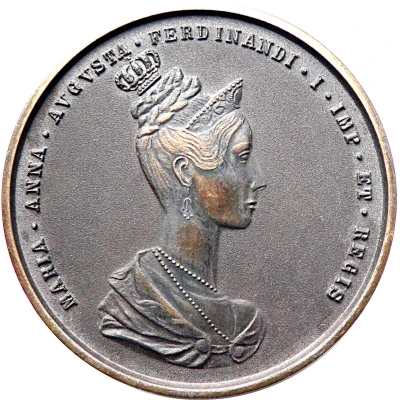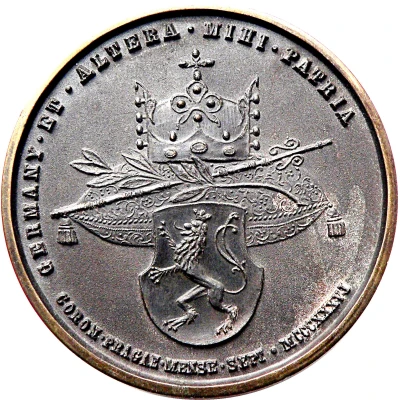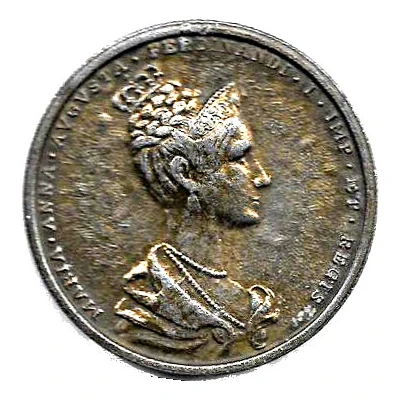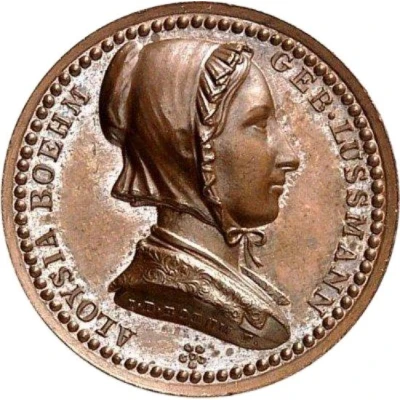


© ZacUK
Medal - Coronation of Maria Anna
1836 year| Bronze (blackened) | 77 g | 75 mm |
| Location | Austrian Empire |
|---|---|
| Type | Medals › Coin replicas |
| Year | 1836 |
| Composition | Bronze (blackened) |
| Weight | 77 g |
| Diameter | 75 mm |
| Thickness | 4.5 mm |
| Shape | Round |
| Technique | Milled |
| Orientation | Medal alignment ↑↑ |
| Demonetized | Yes |
| Updated | 2024-11-14 |
| Numista | N#165291 |
|---|---|
| Rarity index | 85% |
Reverse
Crown and sceptre set upon cushion above the Bohemian coat of arms (shield with lion).
Script: Latin
Lettering:
GERMANY · ET · ALTERA · MIHI · PATRIA
CORON · PRAGAE · MENSE · SEPT · MCCCXXXVI
Translation:
Germany and my other home country
Prague Coronation, month of September 1336
Edge
Plain
Comment
This medal was for celebrating the coronation, of Empress Maria Anna Augusta and Emperor Ferdinandi I, as Queen and King of Bohemia in Prague in September 1836.This (cast copy) has two differences from (original) smaller 46mm medal (link below) ...
Reverse lettering - includes GERMANY (which is an English word, so should
be GERMANIAE like the other Latin lettering)
Reverse lettering - has error date MCCCXXXVI (1336) with D missing
Maria Anna of Austria (Maria Anna Josepha Antonia Regina; 7 September 1683 - 14 August 1754) was Queen Consort of Portugal by marriage to King John V of Portugal. She was Regent of Portugal from 1742 until 1750 during the illness of John V.
Born Maria Anna Josepha, she was a daughter of Holy Roman Emperor Leopold I and Eleonor Magdalene of Neuburg. Maria Anna was a sister of Holy Roman Emperors Joseph I and Charles VI. Through her brother Charles, she was an aunt of Maria Theresa, Austria's only Queen Regnant.
Queen Consort: On 27 October 1708 Maria Anna of Austria married John V, King of Portugal to seal the alliance between the two countries against Bourbon France and Spain during the War of Spanish Succession. She was subsequently Queen of Portugal until his death on 31 July 1750. During her Queenship, she acted as Regent during times of her husband's illness.
Once she was head of her household, Maria Anna reformed her court and its customs to follow the traditions and customs of the traditional Queens of Portugal. Her greatest influence on the court, and Portuguese nobility as a whole, was the increase of segregation between men and women, as well as between servants and masters. Like John, Maria Anna had an exuberant taste, and this was best shown in her famous parties. Often lasting several days, she would invite the nobility from all over the country and hold a magnificent festival, often in concurrence with a Saintly holiday, though religion played a small part in her parties.
Regency: In 1742 Maria Anna took over power as Regent after her husband suffered a stroke, which left him partially paralyzed. When John V died on 31 July 1750, she gave up power to their eldest son Joseph I of Portugal.
She died while in residence in the Palace of Belém in 1754. After her death, she was buried in Lisbon, but her heart was brought to Vienna and buried there in the Imperial crypt.



